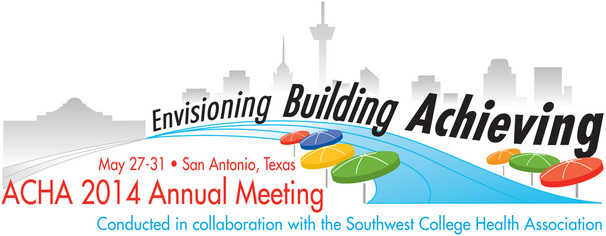By: George Brown, University of Alabama, chair of the Engagement Subcommittee of the ACHA Healthy Campus Coalition and co-chair of the NIRSA Health and Wellbeing Commission
Institutions of higher education across the country encourage students, faculty, staff, alumni, and even community members to attain and maintain health through facilities, programs, and services. Many institutions provide technologically-advanced state-of-the-art recreation and fitness facilities for cardio and strength and conditioning purposes as well as impressive aquatic centers and climbing/challenge course offerings. Convenient hours, safe and well-supervised equipment, and low costs all aid in attracting a wide variety of exercise and fitness enthusiasts.
Encompassing More than Physical Wellbeing
While exercise and fitness play a big role in campus recreation, these programs also impact their campus in further wellness dimensions. In fact, NIRSA: Leaders in Collegiate Recreation (formerly the National Intramural-Recreational Sports Association) recently created and recognized the Health and Wellbeing Commission as a core strategic value of their organization. NIRSA provides a vast array of resources for collegiate recreation departments seeking to maximize awareness and promote health and wellbeing in their campus communities. While recreation offerings on college and university campuses have long been associated with improving physical wellness (stronger bodies, improved muscular tone, increased cardiorespiratory endurance), the NIRSA Health and Wellbeing Commission is seeking to contribute to the dialog on the role and importance campus recreation plays in many other aspects of health.
Outside of physical health, campus recreation resources also impacts:
Institutions of higher education across the country encourage students, faculty, staff, alumni, and even community members to attain and maintain health through facilities, programs, and services. Many institutions provide technologically-advanced state-of-the-art recreation and fitness facilities for cardio and strength and conditioning purposes as well as impressive aquatic centers and climbing/challenge course offerings. Convenient hours, safe and well-supervised equipment, and low costs all aid in attracting a wide variety of exercise and fitness enthusiasts.
Encompassing More than Physical Wellbeing
While exercise and fitness play a big role in campus recreation, these programs also impact their campus in further wellness dimensions. In fact, NIRSA: Leaders in Collegiate Recreation (formerly the National Intramural-Recreational Sports Association) recently created and recognized the Health and Wellbeing Commission as a core strategic value of their organization. NIRSA provides a vast array of resources for collegiate recreation departments seeking to maximize awareness and promote health and wellbeing in their campus communities. While recreation offerings on college and university campuses have long been associated with improving physical wellness (stronger bodies, improved muscular tone, increased cardiorespiratory endurance), the NIRSA Health and Wellbeing Commission is seeking to contribute to the dialog on the role and importance campus recreation plays in many other aspects of health.
Outside of physical health, campus recreation resources also impacts:
- Social Wellbeing: Playing intramural and club sports on teams formed by affinity groups such as residence halls, fraternities, sororities, and faith-based organizations develops an appreciation for teamwork, cooperation, and sportsmanship. Being a part of a group promotes interactions that transcend the sport or activity, creating friendships and support groups.
- Emotional Wellbeing: Working out can provide healthy releases of stress and anxiety often associated with the pressures of college life. Physical activity can improve coping mechanisms that are often challenged in collegiate settings.
- Intellectual Wellbeing: Studies repeatedly show that study breaks – especially those that include physical activities and exercise – improve comprehension and retention of academic course material.

- Spiritual Wellbeing: Many campus recreation programs include mind-body classes, yoga, Pilates, and outdoor recreation opportunities that inspire participants to become more centered. These programs encourage individuals to cultivate the connection between the mind, body, and spirit as well as appreciate the environment in which we live.
- Financial Wellbeing: Most campus recreation facilities are funded through tuition and fees. Students are encouraged to take advantage of these recreation opportunities that are priced well below traditional private health and fitness clubs.
- Environmental Wellbeing: Outdoor recreation opportunities move participants into the natural world. Many programs include learning objectives focused on the preservation and protection of nature as well as the cultivation of a symbiotic relationship with the outdoors.
Involving Campus Recreation in Wellbeing Initiatives
When institutions embark on health and wellbeing initiatives such as Healthy Campus or other campus-wide health programs, recreation departments are often asked to provide resources and expertise on physical wellness. Campus recreation staff and services can impact participants more broadly as well. Recreation centers are high-traffic locations and are a good place to share/post health-related information such as smoking cessation programs, alcohol and other drug awareness campaigns, safe spring break alternatives, and stress reduction resources around final exams.
Recreation Promotion
Getting folks involved in recreation is easy. Many programs offer introductory fitness classes, individual and group personal training, and sports leagues that seek “free agents” who may not have established team connections. Do not let your campus community members be misled by the myth that they have to be a superstar athlete to participate. Today’s campus recreation departments offer something for everyone and provide a way to connect with others who share a desire to stay healthy and well.
Visit your campus recreation facility today to learn more, participate, and connect on campus-wide health and wellness initiatives!
When institutions embark on health and wellbeing initiatives such as Healthy Campus or other campus-wide health programs, recreation departments are often asked to provide resources and expertise on physical wellness. Campus recreation staff and services can impact participants more broadly as well. Recreation centers are high-traffic locations and are a good place to share/post health-related information such as smoking cessation programs, alcohol and other drug awareness campaigns, safe spring break alternatives, and stress reduction resources around final exams.
Recreation Promotion
Getting folks involved in recreation is easy. Many programs offer introductory fitness classes, individual and group personal training, and sports leagues that seek “free agents” who may not have established team connections. Do not let your campus community members be misled by the myth that they have to be a superstar athlete to participate. Today’s campus recreation departments offer something for everyone and provide a way to connect with others who share a desire to stay healthy and well.
Visit your campus recreation facility today to learn more, participate, and connect on campus-wide health and wellness initiatives!
For More Information
Image courtesy: Wikimedia Commons


 RSS Feed
RSS Feed